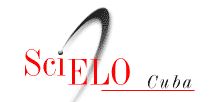Daño miocárdico en la infección por SARS-CoV-2
Resumen
Palabras clave
Referencias
Wu Z, McGoogan JM. Characteristics of and important lessons from the coronavirus disease 2019 (covid-19) outbreak in China: summary of a report of 72 314 cases from the Chinese Center for Disease Control and Prevention. JAMA. 2020;323(13):1239-42.
VanDoremalen N, Bushmaker T, Morris DH, Holbrook MG, Gamble A, Williamson BM, et al. Aerosol and surface stability of SARS-CoV-2 as compared with SARS-CoV-1. N Engl J Med. 2020;382(16):1564-7.
Organización Mundial de la Salud. Report of the WHO-China Joint Mission on Coronavirus Disease 2019 (COVID-19)[Internet]. Ginebra:OMS;2020[citado 23 Sep 2020]. Disponible en: https://www.who.int/docs/default-source/coronaviruse/who-china-joint-mission-on-covid-19-final-report.pdf.
Huang C, Wang Y, Li X, Ren L, Zhao J, Hu Y, et al. Clinical features of patients infected with 2019 novel coronavirus in Wuhan, China. Lancet. 2020;395(10223):497-506.
Wang D, Hu B, Hu C, Zhu F, Liu X, Zhang J, et al. Clinical characteristics of 138 hospitalized patients with 2019 novel coronavirus infected pneumonia in Wuhan, China. JAMA. 2020;323(11):1061-9.
Zheng YY, Ma YT, Zhang JY, Xie X. COVID-19 and the cardiovascular system. Nat Rev Cardiol. 2020;17(5):259-60.
Yang X, Yu Y, Xu J, Shu H, Xia J, Liu H, et al. Clinical course and outcomes of critically ill patients with SARS-CoV-2 pneumonia in Wuhan, China: a single-centered, retrospective, observational study. Lancet Respir Med. 2020;8(5):475-81.
Irabien A, Carreras J, Sionis A, Pamies J, Montiel J, Tauron M. Mocardiitis fulminante por COVID-19. Rev Esp Cardiol[Internet]. 2020[citado 15 Sep 2010];73(6):[aprox. 10p.]. Disponible en:https://www.revespcardiol.org/es-miocarditis-fulminante-por-covid-19-articulo-S0300893220301743.
Shi S, Qin M, Shen B, Cai Y, Liu T, Yang F, et al. Association of cardiac injury with mortality in hospitalized patients with COVID-19 in Wuhan, China. JAMA Cardiol. 2020;5(7):802-10.
MacLaren G, Fisher D, Brodie D. Preparing for the Most Critically III Patients with Covid-19: The potential role of extracorporeal membrane oxygenation. JAMA. 2020;323(13): 1245-6.
Guo T, Fan Y, Chen M, Xu X, Zhang L, He T, et al. Cardiovascular implications of Fatal Outcomes of Patients With Coronavirus Disease 2019 (COVID-19). JAMA Cardiol. 2020;5(7):811-18.
Zhu N, Zhang D, Wang W, Li X, Yang B, Song J, et al. A Novel coronavirus from patients with pneumonia in China, 2019. N Engl J Med. 2020;382(8):727-33.
Xu X, Chen P, Wang J Feng J, Zhou H, Li, X, et al. Evolution of the novel coronavirus from the ongoing Wuhan outbreak and modeling of its spike protein for risk of human transmission. Sci China Life Sci. 2020;63(3):457-60.
Wu Q, Zhou L, Sun X, Yan Z, Hu C, Wu J, et al. Altered Lipid Metabolism in Recovered SARS Patients Twelve Years after Infection. Sci Rep. 2017;7(1):1-12.
Henry C, Zaizafoun M, Stock E, Ghamande S, Arroliga AC, White HD. Impact of angiotensin converting enzyme inhibitors and statins on viralpneumonia. Proc (Bayl Univ Med Cent). 2018;31(4):419-23.
Driggin E, Madhvan MV, Bikdeli B, Chuich T, Laracy J, BondiG, et al. Cardiovascular considerations for patients, health care workers and health system during the COVID-19 pandemic. J Am Coll Cardiol. 2020;75(18):2352-71.
Sellén J, Sellén E, Sellén L, Pena EE. Relación entre sistema renina angiotensina e infección por COVID−19. Rev haban cienc méd[Internet]. 2020[citado 26 Abr 2020]; 19(2):[aprox. 10p.]. Disponible en: http://www.revhabanera.sld.cu/index.php/rhab/article/view/3302/2500.
Inciardi RM, Lupi L, Zaccone G, Italia L, Raffo M, Tomasoni D, et al. Cardiac involvement in a patient with coronavirus disease 2019 (COVID-19). JAMA Cardiol. 2020;5(7):819-24.
Li SS, Cheng CW, Fu CL, Chan Y, Lee M, Chanh J, et al. Left ventricular performance in patients with severe acute respiratory syndrome: a 30-day echocardiographic follow-up study. Circulation. 2003;108(15):1798-803.
Hernández J. Aspectos clínicos relacionados con el Síndrome Respiratorio Agudo Severo (SARS-CoV-2). Rev haban cienc méd[Internet]. 2020[citado 4 Oct 2020]; 19(Suppl.):[aprox. 12p.]. Disponible en: http://www.revhabanera.sld.cu/index.php/rhab/article/view/3279.
Sun P, Lu X, Xu C, Sun W, Pan B. Understanding of COVID-19 based on current evidence. J Med Virol. 2020;92(6):548-51.
IntraMet. COVID-19: Una propuesta de estadificación clínico-terapéutica[Internet]. Buenos Aires:IntraMet;2019[citado 24 Mar 2020]. Disponible en: http://www.intramed.net/contenidover.asp?contenido id=95766.
Hu H, Ma F, Wei X, Fang Y. Coronavirus fulminant myocarditis saved with glucocorticoid and human immunoglobulin. Eur Heart J. 2020;190(4):234-45.
Tang N, Li D, Wang X, Sun Z. Abnormal coagulation parameters are associated with poor prognosis in patients with novel coronavirus pneumonia. J Thromb Haemost. 2020;18(4):844-47.
Guanche H. COVID-19. Un reto para los profesionales de la salud. Rev haban cienc méd[Internet]. 2020[citado 26 Abr 2020];19(2):[aprox. 8p.]. Disponible en: http://www.revhabanera.sld.cu/index.php/rhab/article/view/3284/2484.
Enlaces refback
- No hay ningún enlace refback.
FINLAY EN: 








FINLAY CERTIFICADA POR:

Esta revista "no aplica" cargos por publicación en ninguna etapa del proceso editorial.
Dirección postal: Calle 51A y Avenida 5 de Septiembre Cienfuegos, Cuba Código postal: 55100.
http://www.revfinlay.sld.cu
Telefono: +53 43 516602. Telefax: +53 43 517733.
amgiraldoni@infomed.sld.cu
ISSN: 2221-2434
RNPS: 5129






